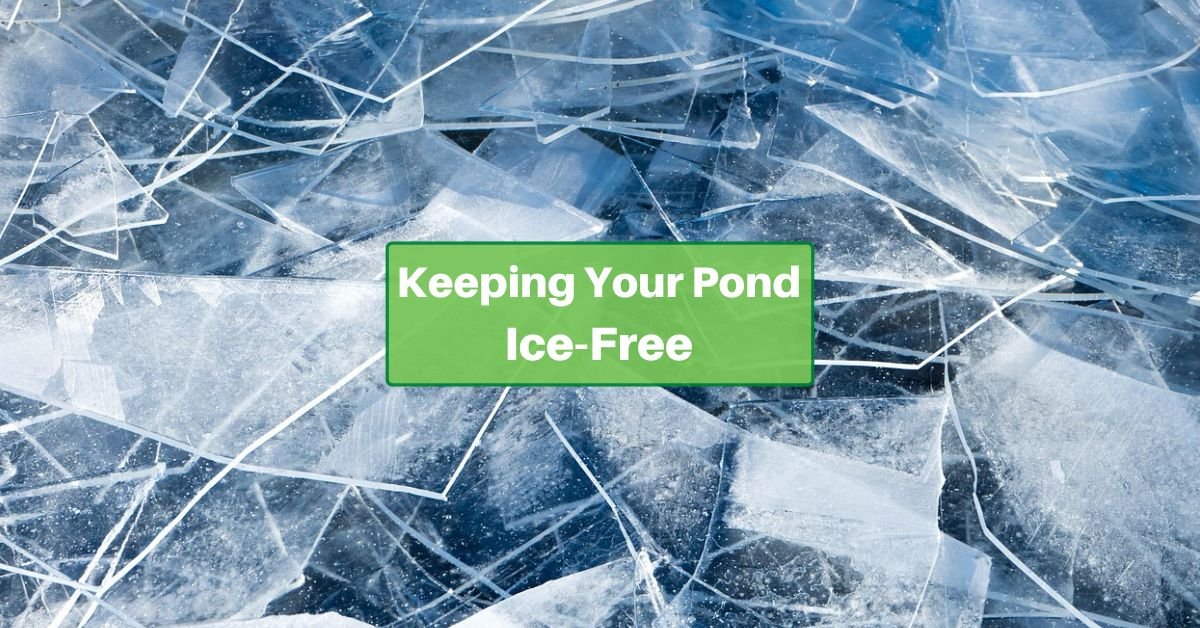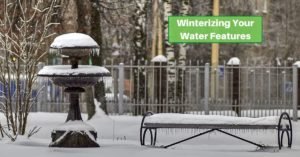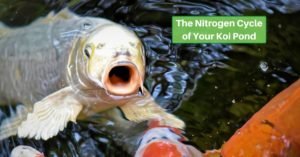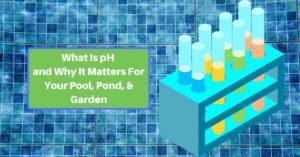Suppose you have a pond and live in a climate with harsh winters. In that case, you face a significant challenge: preventing the water feature from freezing over. Maintaining an ice-free pond helps preserve the aesthetic appeal of your garden during the colder months, but it’s also crucial for the health of the aquatic life residing within. Let’s go over why ponds freeze and how to help cut down or avoid an icy pond altogether!
The Importance of an Ice-Free Pond
A pond is decorative but can also be a complex ecosystem teeming with life. Fish, aquatic plants, and beneficial bacteria rely on the water’s temperature and quality to survive and thrive. When a pond freezes over, it disrupts this delicate balance – often with severe consequences.
One of the most critical issues with a fully frozen pond is the reduction in oxygen levels. Aquatic life, particularly fish, needs oxygen to survive. In a pond covered in ice, the natural exchange of gasses between the water and the air is severely restricted. Oxygen levels drop while carbon dioxide and other harmful gasses build up, creating a hazardous environment for the creatures living in the pond. The sudden death of large numbers of fish is a common result of poor winter pond management.
A frozen pond can also damage aquatic plants. Many pond plants, especially those native to warmer climates, are not adapted to survive extended periods of freezing temperatures. Ice can damage plant tissue, particularly in the roots. This leads to a decline in plant health or even death. Plants play a crucial role in maintaining water quality by absorbing nutrients and providing habitat for other organisms. If they suffer, it can have a domino effect.
The Science Behind Pond Freezing
It’s essential to understand how and why ponds freeze so you can understand how to prevent this issue. Freezing occurs when the water temperature drops to 32°F (0°C), causing the surface to form a layer of ice. However, several factors influence how quickly and to what extent a pond will freeze.
Water Depth: Shallower ponds freeze more quickly than deeper ones because there is less water volume to retain heat. A deeper pond has more thermal mass, which means it takes longer for the entire body of water to cool to freezing temperatures. As a result, the surface may freeze while the deeper areas remain liquid, providing a refuge for fish and other aquatic life.
Surface Area: Ponds with larger surfaces tend to freeze more slowly than smaller ones, as the larger surface area and water volume help retain heat. However, once a large pond does start to freeze, it can be more challenging to keep it ice-free due to the extensive area that needs to be managed.
Exposure to Wind and Sunlight: Wind can accelerate the cooling process by stripping away the warm layer of water at the surface, promoting faster ice formation. On the other hand, sunlight can help keep the water temperature higher, especially if the pond is in a sunny spot with minimal shading. The pond’s exposure to these elements can significantly influence its freezing behavior.
Passive Methods for Preventing Ice Formation
Preventing your pond from freezing over doesn’t always require high-tech equipment or constant attention. Several passive methods can be implemented to reduce the likelihood of ice formation, especially in areas with moderate winters.
Here are some techniques that require minimal maintenance and are relatively cost-effective, making them an excellent first line of defense against winter freezing.
Using a Pond Cover
A pond cover is one of the simplest ways to prevent your pond from freezing. Pond covers work by trapping heat in the water and shielding the surface from cold winds and snow. They also help maintain water temperature, reducing the pond’s rate of losing heat to the surrounding environment.
Types of Pond Covers
Floating Covers: These are lightweight and often made of insulating materials like foam or bubble wrap. They float directly on the water’s surface, creating a barrier between it and the cold air. Floating covers are easy to install and remove, making them a convenient option for seasonal use. However, they may not be suitable for larger ponds or areas with heavy snowfall because they can become weighed down and ineffective.
Mesh Covers: Mesh covers are typically used to keep debris out of the pond but can also serve as a winter cover. While they don’t insulate as effectively as floating covers, they do provide some protection against ice formation by reducing the impact of wind and snow on the water’s surface. Mesh covers are durable and can be left on the pond year-round if desired.
Solid Covers: Solid covers, often made of thick plastic or fiberglass, provide the most effective insulation. They completely enclose the pond, preventing heat loss and minimizing exposure to the elements. Solid covers are ideal for small to medium-sized ponds, especially in regions with severe winters. However, they can be more expensive and challenging to install than other covers. They can also inhibit the exchange of carbon dioxide and oxygen between the air and water, which is vital if you have plants and fish in your pond.
Advantages and Disadvantages:
Pros:
- Reduces heat loss and protects the pond from freezing winds.
- Easy to install and remove, especially for floating and mesh covers.
- It can double as a protective barrier against debris and predators.
Cons:
- Solid covers can be costly and may require more effort to install.
- Floating covers can become waterlogged or weighed down by snow, reducing effectiveness.
- Covers can obstruct the view of the pond, which might be undesirable for aesthetic reasons.
Installing Floating Devices
Another passive method for preventing ice formation is using floating devices on the surface of your pond. These devices keep small areas of the pond surface ice-free, allowing gas exchange and reducing the overall freezing rate.
Types of Floating Devices:
Rubber Balls: Placing a few rubber balls on the pond’s surface can help prevent a solid sheet of ice from forming. As the water cools and begins to freeze, the balls keep small areas of the surface in motion, which helps break up ice formation. Rubber balls are inexpensive, easy to deploy, and can be removed or added as needed throughout the winter.
Wooden Planks or Logs: Like rubber balls, floating wooden planks or logs can also prevent the pond from freezing over completely. The wood acts as a barrier to ice formation, and the natural movement of the water keeps the surrounding areas free from ice. This method is particularly useful in ponds with naturalistic designs, as the wood can blend in with the landscape.
Advantages and Disadvantages:
Pros:
- Simple and cost-effective solution for small ponds.
- Easy to implement and adjust as needed.
- Natural-looking options like wood can enhance the pond’s aesthetic.
Cons:
- It may not be sufficient in frigid climates or for larger ponds.
- Requires regular monitoring and maintenance to ensure effectiveness.
- Limited impact on overall ice prevention compared to more active methods.
Maximizing Water Circulation
Water movement is a crucial factor in preventing ice formation. By keeping the water circulating, you can reduce the likelihood of the surface freezing over. There are several ways to maximize water circulation in your pond, from simple adjustments to your existing setup to installing additional equipment.
Techniques for Enhancing Water Circulation
Positioning Pond Pumps Closer to the Surface: If you have a pond pump installed, try repositioning it closer to the surface during winter. This will create more surface movement, which can help to prevent ice from forming. It’s important to monitor the pump’s performance and adjust its position to maintain optimal circulation.
Using Waterfalls and Fountains: If your pond includes a waterfall or fountain, keep it running during the winter. The constant flow of water generated by these features can significantly reduce the chances of the surface freezing. However, it’s essential to ensure the water flow doesn’t splash onto surrounding areas like walkways, where it could freeze and create hazardous conditions.
Advantages and Disadvantages
Pros:
- It enhances oxygen levels in the water, benefiting aquatic life.
- Simple adjustments can be made to existing equipment.
- Waterfalls and fountains add aesthetic value to the winter landscape.
Cons:
- Requires access to electricity, which may not be feasible in all locations.
- Pumps and fountains need to be monitored to prevent freezing of the equipment itself.
- Depending on the design and climate, water features may contribute to heat loss.
Active Methods for Keeping Your Pond Ice-Free
Passive methods can be effective in preventing ice formation, but sometimes they’re not enough, especially when winters are harsh. In such cases, active methods can provide the extra protection to keep your pond ice-free. These methods use devices and systems that actively work to maintain water temperature and prevent freezing.
Using a Pond Heater
A pond heater, also known as a de-icer, is one of the most reliable ways to keep a pond from freezing. They are designed to keep a small area of the pond’s surface free of ice, allowing gas exchange and maintaining a healthier environment for fish and other aquatic life.
Types of Pond Heaters
Floating De-Icers: Floating de-icers sit on the pond’s surface and keep a small area ice-free. They are typically thermostatically controlled, meaning they only turn on when the water temperature drops to a certain level. This feature helps conserve energy while ensuring the pond remains ice-free.
Submersible Heaters: Submersible heaters are placed underwater and work by heating the water directly. These heaters are often combined with floating de-icers for a comprehensive solution. Submersible heaters are particularly useful in deeper ponds where the water column needs to be kept at a stable temperature.
Advantages and Disadvantages:
Pros:
- Highly effective at preventing ice formation, even in very cold climates.
- Thermostatic control minimizes energy usage, making it more cost-effective.
- It provides a haven for fish by maintaining oxygen levels and preventing harmful gas buildup.
Cons:
- Requires access to electricity, which may be challenging in remote areas.
- Ongoing energy costs, though manageable, can add up over the winter months.
- Potential for equipment failure, which would require immediate attention to avoid pond freezing.
Aeration Systems
Aeration systems are another active method for keeping your pond ice-free. By continually moving water, these systems prevent the formation of a solid ice layer, ensuring that your pond’s ecosystem remains intact throughout the winter.
How Aeration Systems Work
Aeration systems pump air into the water, creating bubbles that rise to the surface. As these bubbles move, they disrupt ice formation, keeping the surface water in motion and oxygenated. Aerators are particularly effective in preventing ice formation in deeper ponds, where water circulation is crucial to maintaining a stable environment.
Types of Aerators
Diffused Air Aerators: These systems use an air pump to push air through a diffuser at the pond’s bottom. The diffuser releases fine bubbles that rise to the surface, creating water movement and preventing ice from forming. Diffused air aerators are effective for larger ponds and can be adjusted to target specific areas.
Surface Aerators: Surface aerators create agitation at the water’s surface by spraying water into the air or using paddle wheels. These systems are generally more powerful and can prevent ice formation over a larger area. However, they may be more energy-intensive than diffused air systems.
Advantages and Disadvantages
Pros:
- It promotes oxygenation, which is beneficial for fish and other aquatic life.
- Effective in larger ponds or in combination with other ice-prevention methods.
- It can be used year-round to enhance water quality, not just during winter.
Cons:
- Higher initial cost compared to passive methods or simpler equipment.
- Requires electricity, which may not be available in all pond locations.
- Some systems can be noisy, which may detract from the tranquil atmosphere of your garden.
Heating the Water with Solar Pond Heaters
Solar pond heaters are an excellent eco-friendly solution. These systems harness the sun’s power to heat the pond water, reducing or eliminating the need for electric heating devices.
How Solar Pond Heaters Work
Solar pond heaters typically consist of solar panels that collect and convert sunlight into heat. This heat is then transferred to the water, either directly through a pump system or via heat exchange panels. The heated water is circulated through the pond, helping to maintain a temperature that prevents ice formation.
Advantages and Disadvantages
Pros:
- Environmentally friendly, using renewable energy to keep your pond warm.
- Long-term savings on electricity costs, especially in sunny climates.
- Low maintenance once installed, with no ongoing energy costs.
Cons:
- High initial setup cost for solar panels and installation.
- Effectiveness depends on the availability of sunlight, which can be limited during winter months.
- It may require supplemental heating during prolonged periods of low sunlight or extreme cold.
Combining Methods for Maximum Efficiency
In many cases, the most effective strategy for keeping your pond ice-free is combining passive and active methods. For example, using a pond cover with a heater or aerator can provide a robust defense against freezing, even in the harshest winter conditions. This layered approach ensures that if one method fails or becomes less effective due to extreme weather, the others can compensate, maintaining a stable environment for your pond’s ecosystem.
Advantages of a Combined Approach
- Increased reliability in preventing ice formation, even in fluctuating temperatures.
- Reduced energy costs by using passive methods to complement active systems.
- Enhanced protection for fish and aquatic plants, maintaining water quality and oxygen levels throughout winter.
Maintenance Tips and Common Concerns
Keeping your pond ice-free during the winter requires the right equipment and techniques, regular maintenance, and attention to detail. Let’s focus on essential maintenance tips to ensure your pond remains in optimal condition throughout the cold months. We’ll also address common concerns and challenges that pond owners face during winter, providing practical solutions to keep your pond healthy and vibrant.
Regular Equipment Checks
One of the most critical aspects of maintaining an ice-free pond is ensuring your equipment functions correctly. No matter your method, regular checks, and maintenance are necessary to avoid unexpected failures.
Tips for Equipment Maintenance
Inspect Cords and Connections: Before the winter season begins, thoroughly inspect all electrical cords and connections for signs of wear, fraying, or damage. Damaged cords can pose a severe safety risk and may cause your equipment to fail when it’s needed most.
Test Equipment Before Winter: Run your pond heater, aerator, or other devices for a few days before the first freeze to ensure they work correctly. This allows you to identify issues and make repairs or replacements before the cold weather sets in.
Monitor Performance: Once your equipment is in use, check it regularly, especially during periods of extreme cold. Look for signs that your pond is starting to freeze and make adjustments as needed to keep the water moving and temperatures above freezing.
Clean Components: Debris can accumulate on heaters, diffusers, and other pond equipment, reducing efficiency. Clean these components regularly to ensure they operate at peak performance. For aeration systems, check the diffusers for any blockages that impede airflow.
Dealing with Unexpected Freezes
Even with the best-prepared systems in place, an unexpected freeze is always possible. Knowing how to respond quickly and effectively can make the difference between a minor inconvenience and significant pond damage.
Steps to Take During an Unexpected Freeze
Act Quickly: If you notice that your pond is starting to freeze, act immediately to prevent further ice formation. Turn up the power on your heater or adjust your aeration system to increase water movement. If your equipment has failed, consider using temporary methods such as hot water or salt (in minimal amounts and only if necessary) to melt the ice until you can make repairs.
Break the Ice Carefully: If ice has already formed, carefully break it using a blunt object such as the back of a shovel or a rubber mallet. Avoid using sharp tools, which can damage the pond liner or harm fish. Breaking the ice creates openings for gas exchange, which is critical for the survival of aquatic life.
Keep an Emergency Kit: Prepare an emergency pond kit with essential supplies like a spare heater, extra tubing, a hand pump, and a battery-operated aerator. These items can help you respond more quickly in case of an equipment failure or sudden freeze.
Common Concerns and Solutions
Winter brings a unique set of challenges for pond owners. Here are some common concerns and practical solutions to help you keep your pond in top condition throughout the cold months.
Concern: Ice Forms Despite Preventative Measures
If ice continues to form despite your efforts, it could be due to a combination of factors, including insufficient equipment, extreme temperatures, or incorrect device placement.
Solution: Reevaluate your equipment’s capacity and placement. For instance, ensure that your heater or aerator is positioned in the deepest part of the pond, where it can have the most significant effect. You may also need to add equipment, such as a secondary aerator or a larger heater, to better combat the cold.
Concern: Pond Water Levels Drops
Water levels can drop during winter due to evaporation or leaks caused by freezing and thawing. Low water levels can expose fish to colder air and increase the risk of ice formation.
Solution: Check water levels regularly and top off the pond as needed. If you suspect a leak, inspect the pond liner and edges for cracks or damage. Repair any issues immediately to prevent further water loss.
Concern: Fish Appear Lethargic or Unhealthy
During winter, fish naturally become less active. Still, if they appear overly lethargic or show signs of distress, it could indicate poor water quality or insufficient oxygen levels.
Solution: Test the water regularly for ammonia, nitrite, and oxygen levels. Ensure that your pond has adequate aeration and that any ice is promptly removed to allow gas exchange. Consider adding a water conditioner designed for winter to improve water quality.
A Final Word
Keeping your pond ice-free during the winter is essential for maintaining a healthy and vibrant aquatic environment. With proper care, equipment, and attention, you can ensure that your pond remains a haven for fish and plants, even during the coldest months.
Winter pond care is not just about keeping the water from freezing—it’s about ensuring that your pond’s ecosystem remains balanced and healthy throughout the season. That can even mean dealing with unexpected freezes that call for quick action and preparedness.
With the right approach, your pond can thrive year-round, providing beauty and tranquility to your outdoor space no matter the weather!









